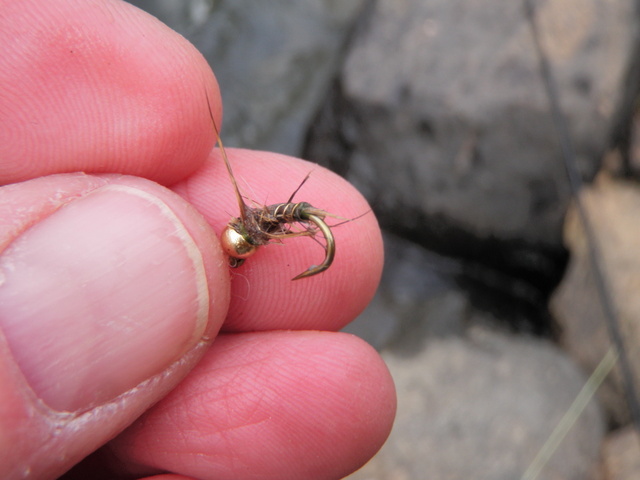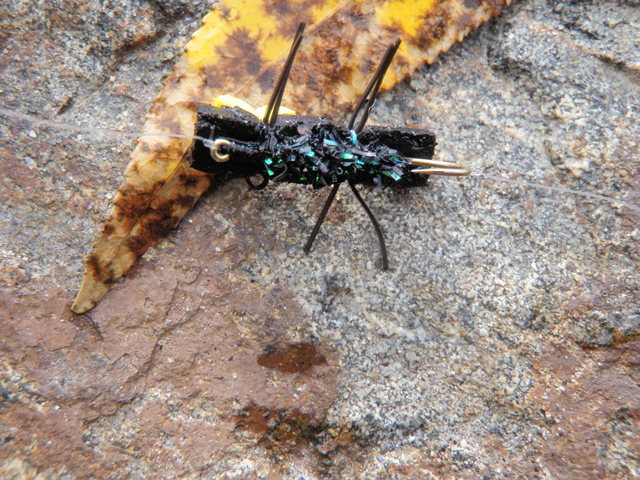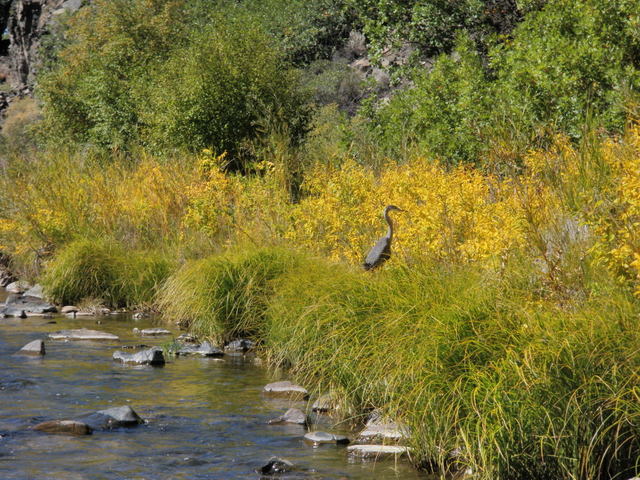Time: 11:00AM – 4:00PM
Location: Fremont – Chafee County line and upstream
Fish Landed: 15
Arkansas River 10/23/2013 Photo Album
Tandem streamers produce in the fall according to the experts. I’ve read about this technique and tested it for an hour in September 2012 on a guided fishing outing with Taylor Edrington. Supposedly big brown trout get territorial and aggressive in October and strike out at invading fish and streamers that venture into their territory. Would Wednesday October 23 be an opportunity to test this theory on the Arkansas River?
As the 2013 fishing season winds down, I lower my expectations for number of fish and size of fish. Once the steady stream of aquatic insect hatches dwindle to midges it seems that the fish become less active and I’ve never been very successful at understanding the timing of brown trout spawning and the impact of this event on catching fish.
A week of cool weather moved into Denver around the time that I had surgery on the back of my hand, so I took a twelve day break from fishing, but weather forecasts predicted a moderate warming trend during the middle of the week so I made plans to fish on Wednesday October 23. My hand seemed to be healed enough to tolerate exposure to water and highs in the low 60’s were comparatively pleasant for mid to late October. I read the fly shop reports on the Arkansas River, and they were encouraging enough that I decided to make the three hour drive.
As I planned the trip I had two goals in mind. One was to use the nymphing rig that I learned from Taylor Edrington that involved a Thingamabobber and level line, and the other was to experiment with a tandem streamer rig on my sink tip line. In preparation for the latter, I found my sink tip line and reel and extracted a length to inspect the leader and sinking tip section. I hadn’t used this line in 20 years, so I wanted to make sure it was in adequate condition for fishing. I concluded it was fishing worthy and made a mental note that it was a 5 weight line.
I arrived at the Fremont – Chafee County pullout by 10AM and the dashboard on the Santa Fe registered 42 degrees and this was accompanied by a light cold breeze. I started adding layers including my long sleeve Columbia undershirt, a fleece and my raincoat as a windbreaker, but as I stood behind the car, I still felt cold so I put on my ski hat for temporay warmth while I rigged my line. It took extra time, but I removed my tapered leader and configured the nymph set up that I learned last September; a six inch section of 0X attached via a loop to loop link to the fly line, and then a clinch knot to tie on the Thingamabobber. I clipped off a fresh five foot length of 3X tippet material and tied that to the Thingamabobber and then extended the five foot leader with another 18 inch section of 5X tippet. I crimped a BB split shot above the surgeon’s knot and then tied on a beadhead hares ear. Next I fed the end of a one foot section of 5X through the eye of the hares ear nymph and tied a clinch knot and then tied on a beadhead RS2 as my point fly.
I removed my ski hat to put on my wide brimmed hat, but I was instantly met with a cold gust of wind, so I whimped out and put my ski hat back on and left the brimmed hat in the car. I packed my lunch in my backpack, but at this point I expected to return to the car for lunch and exchange hats and also perhaps switch to my 5 weight Loomis rod and that would provide the option of trying my sinking tip line and streamers in the afternoon.
I carefully made my way down the crude cement steps and then maneuvered down the rocks to the edge of the large pool below the pullout and carefully waded across the tail. At this point I decided to work my way upstream instead of going downstream as I had done on the previous trip. I was intrigued with the nice pocket water and deep runs along the north bank where I had ended my fishing on the previous Arkansas outing. The nymph rigging and dressing for the cold added precious time to my preparation so that I was finally stationed at my starting point and casting by 10:45AM.
I methodically worked my way up along the right bank with the nymphs for 45 minutes without any sign of fish, and I was beginning to despair that I’d made a three hour trip only to be skunked, but just as that thought entered my brain, the indicator dipped and I landed a nice 12 inch brown that attacked the beadhead hares ear. Within the next half hour I landed three more browns in the same size range with the largest being thirteen inches and a victim of the RS2. Suddenly after an hour of fishing I had landed four fish and my outlook had shifted from despair to optimism.
By noon I was quite hungry and the sun had risen high in the sky and the air temperature warmed considerably. I was now at a turning point where I needed to decide whether to retreat to my morning crossing point and return to the car for lunch and a hat and rod exchange, or simply find a nice rock in the sun and eat my lunch and then continue on upstream. Since it was late in the season with less daylight and a shorter window of actively feeding fish, I didn’t wish to waste an hour trekking back to the car, so I chose the path of least resistance and ate my lunch on a nice rock next to the river. This meant I sacrificed using my sink tip line and I faced the prospect of fishing in the afternoon sun with no brim on my hat.
The decision actually proved to be favorable as I spent the next three and a half hours prospecting the water next to the north bank with my nymph tandem and landed eleven more fish. The most amazing aspect of this day of nymph fishing was that I didn’t lose a single fly to the sticks and rocks on the river bottom despite numerous hang ups. Nearly all my catches were spunky brown trout in the 12-13 inch range with one rainbow landed toward late afternoon. The hares ear nymph produced roughly 75% of the fish, but I switched the RS2 out for a BWO emerger over the last hour and a half, and this fly probably accounted for three fish including the rainbow. I also experienced brief hook ups with two fish that felt heavier, but these fish managed to shake free of the hook in short order.
The most productive water proved to be the head of the runs and slicks where the faster current slowed and fanned out into a slower moving pool and passed over a deeper trough in the run. I probably covered a mile of the river over the course of the 4.5 hours of fishing, so I was definitely moving along quickly and there were some lengthly fishless intervals, but overall it was a fun day in late October on the Arkansas River. Tandem streamer experimentation remains as a goal for a future trip in 2013 before the severe winter weather takes control.

























